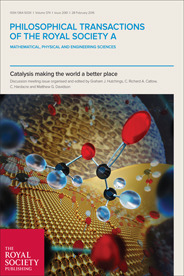Philosophical Transactions of the Royal Society A facts for kids
 |
|
|
Abbreviated title (ISO 4)
|
Philos. Trans. R. Soc. A |
|---|---|
| Discipline | Physics, chemistry, mathematics, engineering, earth sciences, computer science, materials science |
| Language | English |
| Edited by | John Dainton |
| Publication details | |
| Publisher |
Royal Society (United Kingdom)
|
|
Publication history
|
1665–present |
| Frequency | Fortnightly |
|
Open access
|
Hybrid and delayed, after 24 months |
|
Impact factor
(2022) |
5.0 |
| Indexing | |
| ISSN | 1364-503X (print) 1471-2962 (web) |
| LCCN | 97655039 |
| CODEN | PTMSFB |
| OCLC no. | 34435526 |
| Links | |
|
|
Philosophical Transactions of the Royal Society A is a special scientific journal published by the Royal Society. It comes out every two weeks. This journal shares new and important discoveries in many areas of science. These include physics, chemistry, mathematics, and engineering.
Experts check all the articles before they are published. This process is called peer review. You can read articles online a few months before they are printed. All articles become free to read for everyone two years after they are published. The main editor of the journal is John Dainton.
What Does This Journal Publish?
Philosophical Transactions of the Royal Society A creates special issues. Each issue focuses on one important science topic. Leading experts in that field choose the articles. These articles include new research, reviews, and ideas from top scientists.
Some past topics have been about "Supercritical fluids" (special liquids used in green chemistry). Other topics include "Tsunamis: Bridging science, engineering and society." They also covered "Spatial transformations" and the discovery of the "Higgs boson."
A Long History of Science
The journal Philosophical Transactions of the Royal Society started in 1665. It was created by the Royal Society. This makes it the oldest science journal in the English-speaking world.
Henry Oldenburg was the first editor of the journal. In 1887, the journal became two separate publications. One was Philosophical Transactions of the Royal Society A. This part focused on physical sciences, mathematics, and engineering. The other part was Philosophical Transactions of the Royal Society B: Biological Sciences. This one focused on life sciences.
Today, both journals publish special themed issues. They also publish discussions from science meetings. Shorter, individual research articles are published in a different journal. That journal is called Proceedings of the Royal Society.
In 2015, the journal celebrated its 350th birthday. To mark this big event, they published a special collection. It included comments on important papers from the past. These papers were written by famous scientists like Isaac Newton, Humphry Davy, and Michael Faraday.
How Important Is This Journal?
Journals are often measured by their "impact factor." This number shows how often articles from the journal are cited by other scientists. According to the 2022 Journal Citation Reports, this journal has an impact factor of 5.0. This means its articles are often used and referenced by other researchers.

